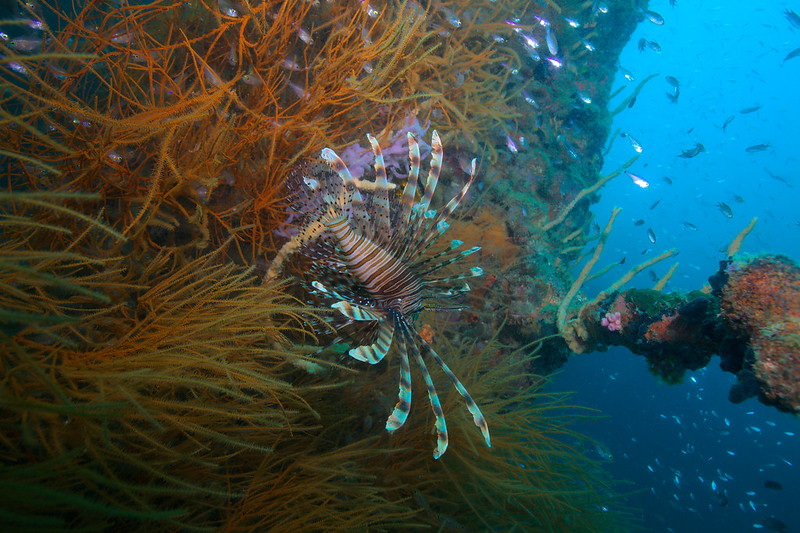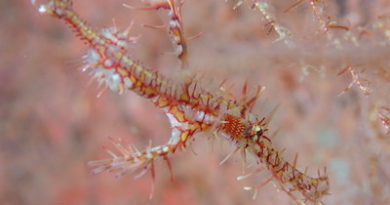Pacificklaus Dive Location Review: Coron, Palawan
In September 1944, the imperial Japanese troops, who had murdered their way mercilessly through Asia, were on the retreat. They were especially lacking, at this point, something which for the first time in a war had become a decisive factor: air support.
To get away from the US airpower, a group of Japanese warships and military supply vessels tried to hide in the waters between Basuanga island (where the town of Coron is located on) in the north and Culion island in the south. It’s clear why this seemed like a good hiding spot to the Japanese Admiralty: The steep, rocky mountains of Busuanga would shield the strait from the north. The many small islands between Culion and Busuanga would make the ships difficult to spot from afar.
The Japanese commanders also thought that they were out of the reach of the US fighter planes (remember, these were still propeller planes). But they were wrong. Despite all the efforts at hiding their ships, they were spotted by a surveillance plane from above, and admiral Chester “Bull” Halsey sent in carrier-based Helldiver and Hellcat dive bombers which made short work of the assembled Japanese ships.
This webpage has some really nice writeups and pictures about Coron war history.
The scene of death, fear and panic for the young men involved in the fighting in 1944 has now turned into an adventure park for divers. The marine life had 7 decades to growth on the wrecks. It’s really something else to dive these sunken ships. The aura of history makes these dives really special. On the Okikawa Maru, a massive tanker, you can see the enormous crater which the dive bomber’s bomb ripped in the bow of the ship. An anti-aircraft gun on the Akizukima is completely overgrown by sponges, but still discernible as a weapon. Did the crew try to avert the sinking to the last minute by using this gun?
Some of the wreck’s interior had been salvaged in the 1950s, which must have been a dangerous and complicated undertaking. Engines and propellers are missing on some of the wrecks, and extra salvage holes (with the metal bent outwards) can be seen on some wrecks.
You can enter many wrecks; The interiors are so voluminous that you won’t have to push yourself through any tight restrictions. You can dive through the innards of these wrecks with always light from the outside visible through holes big enough to use as exits. An exit from the wreck is possible almost at any point of the dive. So you are almost never in a true overhead environment. This is the kind of penetration which would be called a “cavern” in cave diving. There are almost no nets or fishing lines entangled in the wrecks, either. So these are diveable wrecks, even for folks without specialized training in wreck penetration. What makes the dives more challenging though is the depth of some wrecks, below 30 m in the case of the Akizujuma, and the occasional ripping currents at the dive sites. If you come to a wreck when the currents are running, you will have to use the anchor rope (usually fixed on either end of the wrecks) to pull yourself down.
The marine life on the wrecks is a treat, just like the ship’s structures and the historical significance are. Cabbage corals and massive barrel sponges dominate the top of the wrecks. Large trees of brown, fine-fingered soft corals grow on the wrecks’ sides. There are some other hard corals and the usual assembly of tunicates and clams. In a sense, the wrecks look like the deep sections of nearby coastal reefs. The war wrecks also work as true fish magnets: schools of fussiliers forage above them, with trevalleys hunting the fusiliers. On the Okikawa Maru lives a large potato grouper (> 150 cm). I have regularly seen massive map puffers on several of the wrecks, and corocodile … fish resting on top. The inside of the Akizujima in particular is full of baby barracudas (< 15 cm). You will also see many nudibranchs on the outside of the wrecks, there is a big sponge with those white/black-dotted jorunna funebris ones on the Kogyo Maru. Good diving!
How to get there: There are flights from Manila to Coron, and ferry connections from El Nido, Palawan, and from Manila.
Where to stay: I usually stay in the Jasmine Guesthouse in “downtown” Coron, and there are a few other guesthouses in the 1300 Peso range around that area as well. It’s is close to the town square, with lots of little shops and some nice restaurants, like the Bistro Coron (good pizza), and the Vietnamese restaurant “Wa”, which has great Vietnamese coffee (good coffee is a rarity in the Phils!).
Pacificklaus Word War II Carnage Leftover Rating: 6.5/5 points. Oh yes. This is the place to be for wreck aficionados. Short of US Navy dive bombers still circling overhead Coron has it all.


